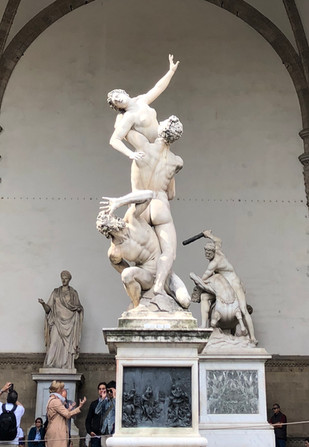Loggia dei Lanzi: Frozen in Motion and Time
- Kelly Hayes
- May 23, 2018
- 4 min read
Updated: May 30, 2018
Guarded by Medici lions, overlooking the Piazza della Signoria, stands a triumphant Perseus, flaunting the severed head of Medusa. Across from him, the Greek hero Hercules wrestles a centaur, captured mid-battle. Stuck in motion, these are but a few statues resting in the Loggia dei Lanzi.
Always open and always free, this open-air sculpture gallery in Florence is a must see for history and art lovers alike. The natural light of the exhibit allows for a unique viewing experience, and immerses the visitor into a 16th century sculpture garden. The Loggia dei Lanzi showcases Italy’s value of historical power and evergreen art, making it an excellent gallery to visit.

History
The Loggia dei Lanzi, also called the Loggia della Signoria or Loggia dell’Orcagna, was originally built between 1376 and 1382 by Benci di Cione and Simone di Francesco Talenti. Situated in Piazza Signoria, adjoining the Uffizi Gallery and across from the Palazzo Pitti, this structure was meant to be used to hold public ceremonies or host assemblies of the Florentine Republic; however, despite its initial intended use, it quickly became a tool to display power.

The custom of displaying statues in the Loggia was started in 1494 by Florentine citizens, in celebration of the expulsion of the Medici family from Florence after a 150-year rule. Transported from the Medici palace, Donatello’s statue of Judith and Holofernes was placed in the Loggia, cleverly chosen for its depiction of a woman decapitating a tyrant.
Soon after this revolt, however, the Medici’s regained power in Florence, and in the 16th century, commissioned sculptors to create pieces for display in the Loggia. Perhaps the most famous statue currently on display is Benvenuto Cellini’s Perseus, which shows a victorious Perseus holding up the detached head of Medusa, was commissioned by Duke Cosimo I in 1554 to act as a symbolic warning to any potential enemies.

In 1583, once the Uffizi was completed, Bernardo Buontalenti created a terrace atop the Loggia, from which the Medici could watch ceremonies in the plaza. Today, this terrace is used for ceremonies and as a rooftop bar for the Uffizi.
Most of the statues on display today in the Loggia were installed in the 18th and 19th century, though created earlier in the 16th century.
On Display
All the works within the Loggia are original, with the exception of the platform of Perseus, said Luana, an ambassador of arts from a Scolopi high school.
Guarding the entrance to this gallery are two Medici lions, which sit between the ends of the center arch – meaning they must be passed to enter. The right lion dates back to the Roman empire, while the other on the left is from 1598. Sculpted from marble by Flaminio Vacca, the left lion was originally situated in Villa Medici in Rome; it was not until 1789 that this lion was placed under the Loggia.

Once up the stairs, you will be directly met with the Loggia’s centerpiece, Menelaus supporting the body of Patroclus, a Roman marble copy of an original Greek work from 240-230 B.C.E. In 1570, this piece was placed near the Ponte Vecchio, and moved under the Loggia in 1741.

From there, you will find the most famous statue in the Loggia on your left: Cellini’s Perseus. Made from bronze and completed in 1554, this statue has been under the Loggia since its completion, but its original base has been moved to the Bargello Museum. Taking nine years to cast, this work shows the Greek hero Perseus holding the head of mythical monster Medusa.
To the back of Perseus is Pio Fedi’s Rape of Polyxena, which is one of the newer statues being housed by the Loggia. Made in 1865, this marble piece has been under the Loggia since its creation.
To your right, you will find Giambologna’s Rape of the Sabine Women, which became part of the gallery in 1583 after being commissioned by the Medici. This statue is the first in European sculptural history to depict a group without a dominant viewpoint – meaning there is no incorrect side to admire it. This work was also made from the largest block of white marble ever transported to Florence.

Behind this work is Giambologna’s lesser known sculpture, Hercules Beating the Centaur Nessus. This piece, also constructed from marble, was completed in 1599, but was not placed under the Loggia until 1841.
Lining the rearmost border of the Loggia are six statues depicting Roman women, called the Sabines. These statues, made from marble, date back to the 2nd century, and were discovered in 1541. They are thought to have come from Trajan’s Foro in Rome, and have been in the Loggia since 1789.
Today
Despite the Loggia’s beautiful display of Renaissance statues, many people use this place as a resting area while waiting for the Uffizi or other historical sites, without grasping the beauty around them, Luana said. However, she would not change a thing about its location.

“The larger area is more free, I think it’s more beautiful,” Luana said.
The way the sunlight hits the statues and paints shadows cannot be replicated indoors, and is a must-see for visitors. At night, this gallery is just as beautiful, with lights set up at just the right points to highlight the works with the backdrop of an evening sky. Typically, local musicians are playing around this area at night, and the mix of sight and sound create a memorable cultural experience.

It was how the art was intended to be displayed, Luana said.
“I really like the idea the 500 years ago someone was seeing the same thing as me,” Luana said. “It beautifies the city; they were made to be placed here.”









Comments